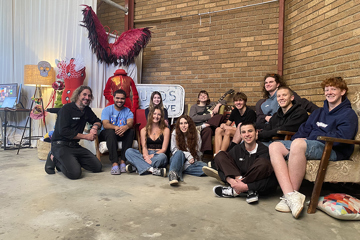We Spoke To The Aussie Artists & Arts Communities Working To Raise Money For Bushfire Relief
Joel Burrows speaks to Estelle Conley from Griffin Theatre Company, Lucy Feagins from Design Files, YA author Emily Gale, and comedian Gerard McGowan about the bushfire fundraising efforts led by artistic communities.
The ongoing Australian bushfire crisis is overwhelming and beyond words. At the time of writing almost 17 million hectares have burned, leading to the loss of an indescribable amount of local flora and fauna. Over 25 people have died, and countless more have lost their homes.
However, in the face of such hopelessness, artistic communities across the country have instigated some incredible fundraising efforts. Artists and arts organisations have been calling on their audiences to donate to those in need.
Griffin Theatre Company in Sydney is one such organisation and has coordinated multiple fundraisers for WIRES. They’re hosting a silent auction for an astroturf armchair from the set of last year’s First Love Is The Revolution, as well as a Facebook fundraiser. Everyone who donates to this fundraiser goes into the running to win a five-play subscription for two for Griffin's 2020 Season.
Editor Lucy Feagins and YA author Emily Gale have also organised auctions to help bushfire-affected areas. Feagins ran an art auction called Arts Fight Fire that raised money for Victoria’s Country Fire Association, WIRES and Wildlife Victoria. Archibald Prize winners like Guy Maestri donated their work to this event, and the auction made over $160,000.
Gale helped start the hashtag #AuthorsforFireys, which saw a myriad of artists sell signed copies of their books, mentorships, and meet and greets. The event raised money for a variety of bushfire services and saw over 900 items go to auction.
Don't miss a beat with our FREE daily newsletter
Assuming we all eat lunch at 12.09pm..
— Emily Gale (@EmilyGale) January 16, 2020
We just zoomed past $250k.
Keep 'em coming. #AuthorsForFireys #AuthorsForFiries https://t.co/bVsIc2CKGQ
Feagins was totally blown away by the visual arts community and how they responded to the auction. “The generosity of the artists involved cannot be overstated,” she says. “We have had artists donating works to this fundraiser which are worth up to $12,000. Choosing to donate this work, rather than sell it, is a really significant thing. That one painting could be a quarter of an artist’s income for the year.”
Gale likewise was blown away by the altruism of the general public. “Several highest bidders upped their highest bid when it came to donating, even though they’d already won!”
Another way creators have raised money for the bushfire effort is by organising shows. Gerard McGowan is one such comedian. He coordinated a comedy show called Bushfire Relief at Sydney’s Giant Dwarf in January, featuring acts like Wil Anderson and Matt Okine, which sold out within two hours. This show helped raise funds for the NSW Rural Fire Service and WIRES.
McGowan says the response from his fellow comics has been overwhelmingly positive. “The acts, many of which are very high-profile, were very quick to get in touch and lend their time to the cause.”
These artists and arts organisations have created these fundraising initiatives during a very turbulent time for the arts in Australia. Australia Council’s grant funding budget has decreased by 19 percent since 2007, with hundreds of creators and companies losing the money they need to make work. Now many people in the arts industry believe that the Liberal Party doesn’t care about their livelihoods, even as the cultural sector contributes $50 billion the Australia’s GDP.
Griffin Theatre Company has been profoundly affected by these budget cuts. “Our operations have been affected in numerous ways,” says Estelle Conley. “We cut our annual mainstage program. We reduced our rehearsal process from five weeks to four. We cut all commissioning and play development programs... While we have managed, our current way of working is not sustainable.”
The Australian Government announced in December they would be merging the arts department with transport, infrastructure and regional development. A lot of creators and arts organisations believe that this merger says a great deal about the Liberal Party. “It’s the government’s way of burying us, and we know it,” says Gale. “The kind of people in power at the moment loathe the arts, and this move is the biggest tell of all.”
“What does transport have to do with art?” McGowan asks. “Nothing. It’s a clear sign. Just like going on holiday while the country burns is a sign.”
Our artistic communities have given their time, money and creative works in order to support bushfire-affected communities – even after the Australian Council had its budget cut and the Government revealed the merger. Conley believes that this is because “the arts community is deeply committed to the wellbeing and positive future of our Australian community". "It’s knitted into the fabric of everything that we do," she says. "We are resilient, flexible, and punch well above our weight when it comes to giving back."
Feagins believes that there’s a sense of camaraderie underlying these bushfire fundraising efforts. “No matter what challenges artists and arts organisations face, there’s an... independent spirit, a resilience, and even a sense of defiance within the arts community. This underfunded sector, made up of people who represent some of the most underpaid professions in the country, are leading the charge. It’s incredibly powerful.”
McGowan believes that the bushfire fundraising efforts made by artists, creators and arts organisations says a lot about the community. But he is even more impressed with the amount of money the Australian general public has donated. “It has really restored my faith in humanity. If everyone does their part, we might just pull through this. Hopefully this show helps me do some of mine.”







